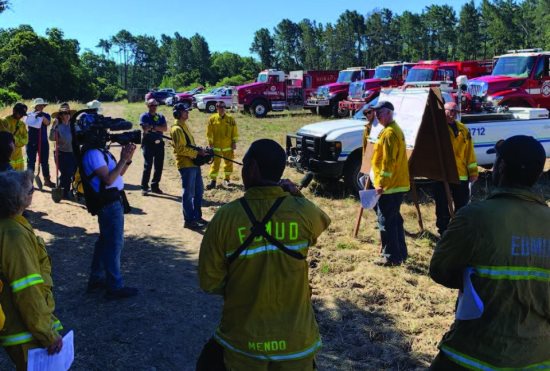 | | | MOFD's Dennis Rein outlines the day's program to fuel break participants July 11 Photo courtesy Mike Marquart, MOFD | | | | | | The Moraga-Orinda Fire District and its program partners July 11 kicked off the North Orinda Shaded Fuel Break project, a state-funded effort to prevent a catastrophic wildfire by removing dangerous fuels along a 14-mile ridge from Tilden Park to Acalanes High School. The kickoff featured the first major test of MOFD-developed heat sensing technology, which detects components of fire behavior and forwards the data for preparation of an evacuation plan.
 "It was one of the most exciting demonstrations ever put on in the world of wildfire prevention, taking data from the sensors to provide an evacuation model," said Tim Woodbury of Splunk Technology, a San Francisco data analytics company that parsed the information.
"It was one of the most exciting demonstrations ever put on in the world of wildfire prevention, taking data from the sensors to provide an evacuation model," said Tim Woodbury of Splunk Technology, a San Francisco data analytics company that parsed the information.
 The district tested heat sensing technology on a small scale during evacuation drills in December and January. "The system detected and transmitted data that resulted in both an alert, fire modeling and notifications to public safety," said Dennis Rein, MOFD emergency preparedness coordinator, who supervised the drills.
The district tested heat sensing technology on a small scale during evacuation drills in December and January. "The system detected and transmitted data that resulted in both an alert, fire modeling and notifications to public safety," said Dennis Rein, MOFD emergency preparedness coordinator, who supervised the drills.
 Shortly afterward, the Gordon and Betty Moore Foundation expressed interest in the sensor program, and through the Rescue One Foundation, which has contributed more than $500,000 to the fire service over 42 years, authorized a $100,000 grant to MOFD for the venture. Genny Biggs of the Moore Foundation called the program "a promising and potentially life-saving, near-term tech solution to reducing the threat and impact of severe wildfires. We believe the system MOFD has developed could significantly improve early detection and response."
Shortly afterward, the Gordon and Betty Moore Foundation expressed interest in the sensor program, and through the Rescue One Foundation, which has contributed more than $500,000 to the fire service over 42 years, authorized a $100,000 grant to MOFD for the venture. Genny Biggs of the Moore Foundation called the program "a promising and potentially life-saving, near-term tech solution to reducing the threat and impact of severe wildfires. We believe the system MOFD has developed could significantly improve early detection and response."
 To produce the prototypes, MOFD teamed up with various partners including Analog Devices, which built the sensors, and ZoneHaven, a newly formed company that developed the software system.
To produce the prototypes, MOFD teamed up with various partners including Analog Devices, which built the sensors, and ZoneHaven, a newly formed company that developed the software system.
 At the fuel break kickoff, the district placed 200 sensors around a 15-acre controlled burn off of Bear Creek Road in north Orinda. The sensors picked up a rise in temperature and triggered a simulation model of where the fire would spread over the next five hours. That information was used to determine and recommend an evacuation plan, to be put in place by the appropriate public safety agencies. "The sensors all worked perfectly," said MOFD Chief Dave Winnacker
At the fuel break kickoff, the district placed 200 sensors around a 15-acre controlled burn off of Bear Creek Road in north Orinda. The sensors picked up a rise in temperature and triggered a simulation model of where the fire would spread over the next five hours. That information was used to determine and recommend an evacuation plan, to be put in place by the appropriate public safety agencies. "The sensors all worked perfectly," said MOFD Chief Dave Winnacker
 Robert Shear of ZoneHaven sees the program as far more than simply detecting fire conditions. "We've built a community collaboration platform for wildfires, evacuations and any type of natural disaster," he said. "We want to help communities understand the real threats and understand more about their evacuation zones. Our real value is bringing this interface to the community."
Robert Shear of ZoneHaven sees the program as far more than simply detecting fire conditions. "We've built a community collaboration platform for wildfires, evacuations and any type of natural disaster," he said. "We want to help communities understand the real threats and understand more about their evacuation zones. Our real value is bringing this interface to the community."
 Other technology exists to detect wildfires, including satellite programs, automated surveillance and other sensor products. But Shear said that only the MOFD sensor program gives an instantaneous readout of fire danger along with an evacuation model. "You don't have hours when a wildfire hits. You have minutes," Shear said.
Other technology exists to detect wildfires, including satellite programs, automated surveillance and other sensor products. But Shear said that only the MOFD sensor program gives an instantaneous readout of fire danger along with an evacuation model. "You don't have hours when a wildfire hits. You have minutes," Shear said.
 Though the fire district developed the sensor technology under Winnacker's leadership, MOFD cannot convert the concept into a marketable product, because that is not what a public agency does. That is the challenge for ZoneHaven, which is looking at private-public partnerships and also a subscription model for property owners.
Though the fire district developed the sensor technology under Winnacker's leadership, MOFD cannot convert the concept into a marketable product, because that is not what a public agency does. That is the challenge for ZoneHaven, which is looking at private-public partnerships and also a subscription model for property owners.
 "We want this to become a common platform across all of California," Shear said.
"We want this to become a common platform across all of California," Shear said. |
